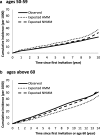Overdiagnosis in the population-based organized breast cancer screening program estimated by a non-homogeneous multi-state model: a cohort study using individual data with long-term follow-up
- PMID: 30558679
- PMCID: PMC6296133
- DOI: 10.1186/s13058-018-1082-z
Overdiagnosis in the population-based organized breast cancer screening program estimated by a non-homogeneous multi-state model: a cohort study using individual data with long-term follow-up
Abstract
Background: Overdiagnosis, defined as the detection of a cancer that would not become clinically apparent in a woman's lifetime without screening, has become a growing concern. Similar underlying risk of breast cancer in the screened and control groups is a prerequisite for unbiased estimates of overdiagnosis, but a contemporary control group is usually not available in organized screening programs.
Methods: We estimated the frequency of overdiagnosis of breast cancer due to screening in women 50-69 years old by using individual screening data from the population-based organized screening program in Stockholm County 1989-2014. A hidden Markov model with four latent states and three observed states was constructed to estimate the natural progression of breast cancer and the test sensitivity. Piecewise transition rates were used to consider the time-varying transition rates. The expected number of detected non-progressive breast cancer cases was calculated.
Results: During the study period, 2,333,153 invitations were sent out; on average, the participation rate in the screening program was 72.7% and the average recall rate was 2.48%. In total, 14,648 invasive breast cancer cases were diagnosed; among the 8305 screen-detected cases, the expected number of non-progressive breast cancer cases was 35.9, which is equivalent to 0.43% (95% confidence interval (CI) 0.10%-2.2%) overdiagnosis. The corresponding estimates for the prevalent and subsequent rounds were 15.6 (0.87%, 95% CI 0.20%-4.3%) and 20.3 (0.31%, 95% CI 0.07%-1.6%), respectively. The likelihood ratio test showed that the non-homogeneous model fitted the data better than an age-homogeneous model (P <0.001).
Conclusions: Our findings suggest that overdiagnosis in the organized biennial mammographic screening for women 50-69 in Stockholm County is a minor phenomenon. The frequency of overdiagnosis in the prevalent screening round was higher than that in subsequent rounds. The non-homogeneous model performed better than the simpler, traditional homogeneous model.
Keywords: Breast cancer; Mammography; Multi-state model; Organized screening program; Overdiagnosis.
Conflict of interest statement
Ethics approval and consent to participate
The present study was approved by the ethics committee in Umeå, Sweden (Dnr 2015/57–31 and Dnr 2017–166-32 M).
Consent for publication
Not applicable.
Competing interests
The authors declare that they have no competing interests.
Publisher’s Note
Springer Nature remains neutral with regard to jurisdictional claims in published maps and institutional affiliations.
Figures


Similar articles
-
Estimation of overdiagnosis in breast cancer screening using a non-homogeneous multi-state model: A simulation study.J Med Screen. 2018 Dec;25(4):183-190. doi: 10.1177/0969141317733294. Epub 2017 Nov 19. J Med Screen. 2018. PMID: 29153013
-
Annual mammographic screening to reduce breast cancer mortality in women from age 40 years: long-term follow-up of the UK Age RCT.Health Technol Assess. 2020 Oct;24(55):1-24. doi: 10.3310/hta24550. Health Technol Assess. 2020. PMID: 33141657 Free PMC article. Clinical Trial.
-
Obligate Overdiagnosis Due to Mammographic Screening: A Direct Estimate for U.S. Women.Radiology. 2018 May;287(2):391-397. doi: 10.1148/radiol.2017171622. Epub 2017 Dec 21. Radiology. 2018. PMID: 29267146
-
[Discrepancies and overdiagnosis in breast cancer organized screening. A "methodology" systematic review].Rev Epidemiol Sante Publique. 2018 Nov;66(6):395-403. doi: 10.1016/j.respe.2018.08.007. Epub 2018 Oct 11. Rev Epidemiol Sante Publique. 2018. PMID: 30316554 French.
-
Overdiagnosis of breast cancer at screening is clinically insignificant.Acad Radiol. 2015 Aug;22(8):961-6. doi: 10.1016/j.acra.2015.01.020. Epub 2015 Mar 18. Acad Radiol. 2015. PMID: 25797300 Review.
Cited by
-
The "Sweet Spot" Revisited: Optimal Recall Rates for Cancer Detection With 2D and 3D Digital Screening Mammography in the Metro Chicago Breast Cancer Registry.AJR Am J Roentgenol. 2021 Apr;216(4):894-902. doi: 10.2214/AJR.19.22429. Epub 2021 Feb 10. AJR Am J Roentgenol. 2021. PMID: 33566635 Free PMC article.
-
Global, Regional, and National Burden of Breast Cancer, 1990-2021, and Projections to 2050: A Systematic Analysis of the Global Burden of Disease Study 2021.Thorac Cancer. 2025 May;16(9):e70052. doi: 10.1111/1759-7714.70052. Thorac Cancer. 2025. PMID: 40320297 Free PMC article.
-
Estimation of Breast Cancer Overdiagnosis in a U.S. Breast Screening Cohort.Ann Intern Med. 2022 Apr;175(4):471-478. doi: 10.7326/M21-3577. Epub 2022 Mar 1. Ann Intern Med. 2022. PMID: 35226520 Free PMC article.
-
Benefits and harms of breast cancer screening: Cohort study of breast cancer mortality and overdiagnosis.Cancer Med. 2023 Sep;12(17):18120-18132. doi: 10.1002/cam4.6373. Epub 2023 Aug 7. Cancer Med. 2023. PMID: 37548277 Free PMC article.
-
Non-progressive breast carcinomas detected at mammography screening: a population study.Breast Cancer Res. 2023 Jul 4;25(1):80. doi: 10.1186/s13058-023-01682-9. Breast Cancer Res. 2023. PMID: 37403150 Free PMC article.
References
Publication types
MeSH terms
LinkOut - more resources
Full Text Sources
Medical

